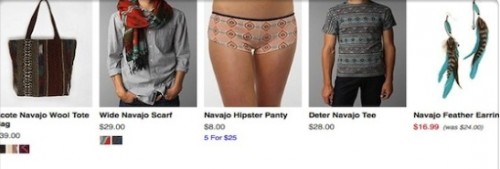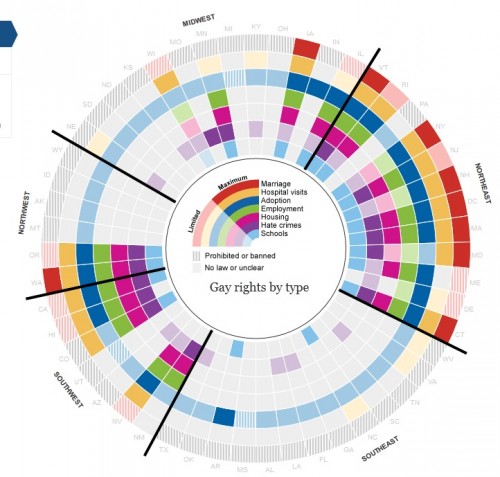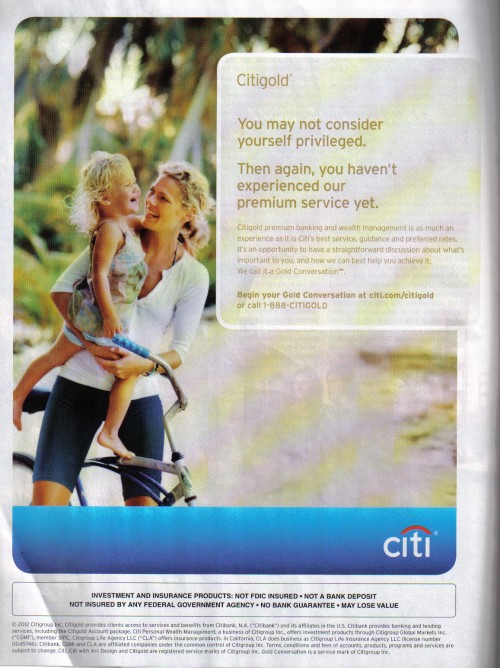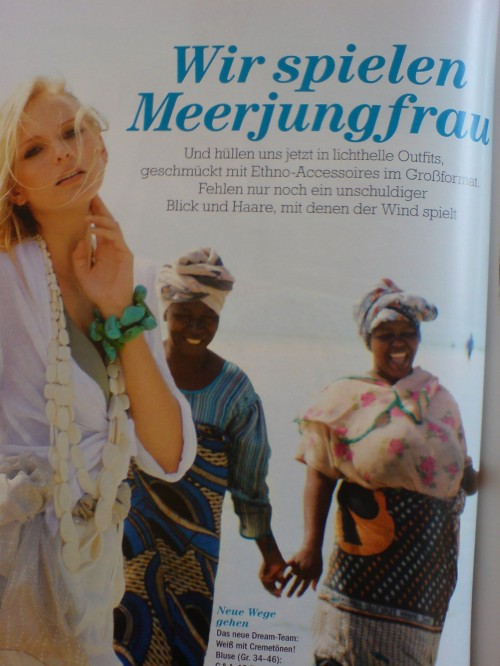Yesterday Native Appropriations featured a presentation about Urban Outfitters, cultural appropriation in fashion, and the struggle to get the clothing chain to stop labeling clothing as “Navajo.” The presentation is great both for explaining this particular case — which included the Navajo nation sending a cease-and-desist letter demanding that Urban Outfitters stop using the term Navajo in its marketing — and also because it shows how one particular story spread through social media, which increasingly have the ability to bring mainstream media attention to stories that otherwise might have gone unnoticed.
Archive: May 2012
Yesterday I stumbled upon a really great interactive graphic posted by the Guardian that summarizes the degree to which a number of rights and benefits are available to gays and lesbians in the U.S., by state. Each state is represented as a segment radiating out from the center of the circle; each colored ring represents a particular right, benefit, or protection:
- Light blue = whether state has a law addressing discrimination or bullying in the school system
- Purple = state-level hate-crime laws
- Pink = protection against housing discrimination
- Green = protection against employment discrimination
- Blue = right to adopt (lighter shade indicates individuals are allowed; darker shade means gay and lesbian couples are allowed to jointly adopt)
- Yellow = right to visit partner in the hospital
- Red = marriage
The different shades indicate differences in the scope of coverage (say, full marriage rights vs. domestic partnership — and it has been updated to reflect yesterday’s passage of the bill outlawing same-sex marriage in North Carolina — or whether a law bans discrimination based on sexual orientation but not gender identity); the Guardian website explains each issue. Their post also allows you to hover over a state and get a more detailed summary. Here’s the info for Nevada, for instance:
The graphic also lets you scale states by population if you want to get a better sense of the proportion of the U.S. population living in areas that do or do not provide these protections.
A while back, in a post of test prep for kindergarten entrance exams, I criticized the idea that we should be giving our children every advantage. Have every advantage over who? Somehow, I wrote, “the fact that advantaging your child disadvantages other people’s children gets lost. If it advantages your child, it must be advantaging him over someone else; otherwise it’s not an advantage, you see?”
This notion applies, also, to our adult lives, as manifest in a post about the “luxury” of drinking tea that was especially time-consuming to prepare. We’re supposed to find appealing the idea that someone else has had to work really hard for our pleasure and comfort. Really?
I thought of both of these examples when I saw this Citigold ad, submitted by vmlojw. The copy reads, “You may not consider yourself privileged. Then again, you haven’t experienced our premium service yet.”
What is interesting to me about this is the assumption that we should all seek to have MORE than other people. The ad doesn’t suggest that we should seek to be comfortable or have enough to get by, but instead appeals to the idea that we must all want a “premium” life, one that is characterized by having more than other people.
And this isn’t interpreted to mean that you’re greedy or arrogant. It doesn’t reflect on your character negatively. Instead, being on the top of a hierarchy is something to aspire to. The fact that that your being on top requires other people to be on the bottom is of no concern. The pleasures and comforts of being on the top are things that we should enjoy without qualms.
Meanwhile, the existence of hierarchy itself — the idea that we must live in a world where some people have so much and others have so little — is never questioned. I think there’s a nearly-invisible American value here that I would like us to talk more about.
Lisa Wade, PhD is an Associate Professor at Tulane University. She is the author of American Hookup, a book about college sexual culture; a textbook about gender; and a forthcoming introductory text: Terrible Magnificent Sociology. You can follow her on Twitter and Instagram.
 The splashy introduction of the new LEGO friends line earlier this year stirred up a lot of controversy. My goal with this set of posts is to provide some historical perspective for the valid concerns raised in this heated debate.
The splashy introduction of the new LEGO friends line earlier this year stirred up a lot of controversy. My goal with this set of posts is to provide some historical perspective for the valid concerns raised in this heated debate.
1932-1977: The Brick Era
The LEGO Group started as a family business with the motto “only the best is good enough.” The company produced primarily wooden toys for the first two decades of its existence. It wasn’t until 1958 that the iconic LEGO brick was patented as we know it today. LEGO bricks were originally marketed as toys for both boys and girls. The 60s saw the introduction of new elements to the LEGO system like wheels, windows and hinges. Marketing images from this era tend to feature boys and girls equally.

In the 70s we encounter the first LEGO theme marketed specifically at girls: Homemaker. The sets aren’t very different from the rest of the products offered at that time (there’s some bricks and you build stuff), but the pictures of smiling girls playing with the sets clearly mark them as “girls only.” Homemaker sets are clearly meant to be furniture for dolls.
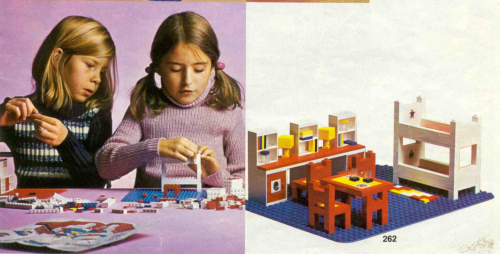
Dolls are popular toys, so finding ways to integrate the LEGO experience into this existing model of play was a shrewd business strategy for TLG, but one that nevertheless perpetuated stereotypes.
The 70s also saw TLG experimenting with different types of human-like figures. The first figures (sometimes called maxifigs to contrast with their later mini brethren) were built from regular LEGO bricks and new head pieces. These appeared in a line of sets with the uninspired name “LEGO Building Sets with People.” These line as a whole was marketed at both boys and girls, but some sets were more targeted. Co-existing for a brief period with the maxifig was a proto-minifigure. The minifig we all know and love today was next.
1978-1988: The Golden Era
In 1978 the minifigure first appeared as we know it today and, after an awkward period of co-existence with the maxifigs, the “minifig” became the standard for tiny plastic people. The minifig is now as iconic as the LEGO brick and equally important in defining the LEGO brand, over the years has tried to introduce other types of figures, but none of them have the staying power of the minifig. For the next decade LEGO minifigs existed in a gender neutral utopia. One can argue that the hairstyles are slightly gendered, but keep in mind that unisex hairstyles were all the rage at the time. When people talk about wanting to get back to the “good old days” of LEGO, this is generally the decade they are referring to.
For the next decade LEGO minifigs existed in a gender neutral utopia. One can argue that the hairstyles are slightly gendered, but keep in mind that unisex hairstyles were all the rage at the time. When people talk about wanting to get back to the “good old days” of LEGO, this is generally the decade they are referring to.
In response to the LEGO Friends launch a lot of people have been passing around these images from an early 80s ad campaign: Even at this time, however, LEGO was promoting gendered play. The short-lived Scala Jewelry theme, for example was a major deviation from the core LEGO product line. There is virtually no building in these sets, they are completely superficial — a triumph of style over substance.
Even at this time, however, LEGO was promoting gendered play. The short-lived Scala Jewelry theme, for example was a major deviation from the core LEGO product line. There is virtually no building in these sets, they are completely superficial — a triumph of style over substance.
Contrast this with Technic, which is all substance and no style. These complicated sets (originally called Expert builder sets) are clearly for boys. Boys also seem to have taken over LEGO trains. It’s great that TLG provides a range of products for builders of all skill levels, but why is it that the products for girls are always on the low-skill side of the spectrum and the high-skill side always reserved for boys?

The segregation of LEGO into feminine and masculine sets would escalate in the next 15 yrs, however, and I’ll cover that development in the next installment.
Read Part II of A Historical Perspective on the LEGO Gender Gap.
—————————
David Pickett is a social media marketer by day and a LEGO animator by night. He is fanatical about LEGO and proud to be a nerd. Read more from David at Thinking Brickly.
We’ve posted a number of times on the use of non-Western locations, and their residents, as background props in ads, catalogs, and fashion spreads, and the examples keep coming. A while back, Rebecca Smith-Mandin sent in this ad for Conrad hotels, in which the implicitly wealthy, White audience is invited to indulge in “the luxury of being yourself,” which includes the ability to have authentic, off-the-beaten-path experiences in far-flung locales, while remaining clearly distinct from them:
Similarly, last year Anna-Sara H. found this image in the German women’s magazine Freundin:
Anna-Sarah’s translation (which she says loses some of the poetic intent of the original):
We are playing mermaid. And wrap ourselves in light-bright outfits now, adorned with large-sized ethnic accessories. The only things missing are an innocent gaze and hair being played with by the wind.
In both cases, we see a very common trend in ads or photo shoots for fashion and luxury services: non-White individuals may be included in the photo shoot, but they are not used to model the use of the product or service itself. As Ashley Mears argues in her ethnography of modeling, Pricing Beauty: The Making of a Fashion Model, non-White bodies are generally seen as incompatible with the idealized fantasy of inaccessibility and sophistication that is the guiding aesthetic for fashion mag editorials and advertisements for luxury goods. In these images, we see that non-Whites are included in a way that superficially increases diversity in a magazine’s pages, without disrupting the assumption that the imagined consumer — the subject of these images — is White.
Cross-posted at Montclair SocioBlog.
Jacob and Isabella were the most popular baby names last year. Some observers, even some sociologists, see this as the influence of the Twilight series. (See here for example.)
But Jacob, Isabella, and even Bella were on the rise well before Stephanie Meyer sent her similarly-named characters out to capture the hearts, minds, and naming preferences of romantic adolescents:
The forecasters predict a bumper crop soon in Rue, Cato, and perhaps other names that are from the Hunger series. Still, since the YA (Young Adult) audience for these books and movies are more Y than A, I’m hoping for lag time of at least a few years before they start naming babies. As I blogger earlier, Splash, the film with Darryl Hannah as Madison the mermaid, came out in 1984, but it was not until nine years later that Madison surfaced in the top 100 names. And if there’s a Hogwarts effect, we’re still waiting to see it. The trend in Harry and Harold is downward on both sides of the Atlantic, and Hermione has yet to break into the top 1000.
Don’t look for any Katnisses to be showing up in your classes for quite a while.
 Alexandra O’Dell, a student at North Idaho College, does a great job of integrating data, interviews, and images in this 11-minute video about the sexualization of young girls in the media:
Alexandra O’Dell, a student at North Idaho College, does a great job of integrating data, interviews, and images in this 11-minute video about the sexualization of young girls in the media:
Lisa Wade, PhD is an Associate Professor at Tulane University. She is the author of American Hookup, a book about college sexual culture; a textbook about gender; and a forthcoming introductory text: Terrible Magnificent Sociology. You can follow her on Twitter and Instagram.
 Dolores R. sent in a flubbed opportunity to represent Mexicans positively and reach out to the expanding Mexican market in the U.S. In “honor” of Cinco de Mayo, Mike’s Hard Lemonade hired five men — in fake mustaches and sombreros — to pretend to be a Mariachi band. They then improvised songs in response to submissions from viewers. The stunt is self-conscious, along the lines of the “ironic” “hipster racism” we now see so much of.
Dolores R. sent in a flubbed opportunity to represent Mexicans positively and reach out to the expanding Mexican market in the U.S. In “honor” of Cinco de Mayo, Mike’s Hard Lemonade hired five men — in fake mustaches and sombreros — to pretend to be a Mariachi band. They then improvised songs in response to submissions from viewers. The stunt is self-conscious, along the lines of the “ironic” “hipster racism” we now see so much of.
The fake band may have been making fun of themselves, but they did so by engaging in something that they had already decided was ridiculous, Mariachi music. Happy Cinco de Mayo, everyone.
A better approach, Latino Rebels suggests, would have been to spotlight some of the actual awesome Mariachi music out there. They wouldn’t have even had to be traditional. They could have hired a real band to improvise, or they could have drawn on the existing Mariachi cover bands, bands that do really neat stuff! Here’s, for example, is a band covering Hotel California:
Lisa Wade, PhD is an Associate Professor at Tulane University. She is the author of American Hookup, a book about college sexual culture; a textbook about gender; and a forthcoming introductory text: Terrible Magnificent Sociology. You can follow her on Twitter and Instagram.
Yesterday I stumbled upon a really great interactive graphic posted by the Guardian that summarizes the degree to which a number of rights and benefits are available to gays and lesbians in the U.S., by state. Each state is represented as a segment radiating out from the center of the circle; each colored ring represents a particular right, benefit, or protection:
- Light blue = whether state has a law addressing discrimination or bullying in the school system
- Purple = state-level hate-crime laws
- Pink = protection against housing discrimination
- Green = protection against employment discrimination
- Blue = right to adopt (lighter shade indicates individuals are allowed; darker shade means gay and lesbian couples are allowed to jointly adopt)
- Yellow = right to visit partner in the hospital
- Red = marriage
The different shades indicate differences in the scope of coverage (say, full marriage rights vs. domestic partnership — and it has been updated to reflect yesterday’s passage of the bill outlawing same-sex marriage in North Carolina — or whether a law bans discrimination based on sexual orientation but not gender identity); the Guardian website explains each issue. Their post also allows you to hover over a state and get a more detailed summary. Here’s the info for Nevada, for instance:
The graphic also lets you scale states by population if you want to get a better sense of the proportion of the U.S. population living in areas that do or do not provide these protections.
A while back, in a post of test prep for kindergarten entrance exams, I criticized the idea that we should be giving our children every advantage. Have every advantage over who? Somehow, I wrote, “the fact that advantaging your child disadvantages other people’s children gets lost. If it advantages your child, it must be advantaging him over someone else; otherwise it’s not an advantage, you see?”
This notion applies, also, to our adult lives, as manifest in a post about the “luxury” of drinking tea that was especially time-consuming to prepare. We’re supposed to find appealing the idea that someone else has had to work really hard for our pleasure and comfort. Really?
I thought of both of these examples when I saw this Citigold ad, submitted by vmlojw. The copy reads, “You may not consider yourself privileged. Then again, you haven’t experienced our premium service yet.”
What is interesting to me about this is the assumption that we should all seek to have MORE than other people. The ad doesn’t suggest that we should seek to be comfortable or have enough to get by, but instead appeals to the idea that we must all want a “premium” life, one that is characterized by having more than other people.
And this isn’t interpreted to mean that you’re greedy or arrogant. It doesn’t reflect on your character negatively. Instead, being on the top of a hierarchy is something to aspire to. The fact that that your being on top requires other people to be on the bottom is of no concern. The pleasures and comforts of being on the top are things that we should enjoy without qualms.
Meanwhile, the existence of hierarchy itself — the idea that we must live in a world where some people have so much and others have so little — is never questioned. I think there’s a nearly-invisible American value here that I would like us to talk more about.
Lisa Wade, PhD is an Associate Professor at Tulane University. She is the author of American Hookup, a book about college sexual culture; a textbook about gender; and a forthcoming introductory text: Terrible Magnificent Sociology. You can follow her on Twitter and Instagram.
 The splashy introduction of the new LEGO friends line earlier this year stirred up a lot of controversy. My goal with this set of posts is to provide some historical perspective for the valid concerns raised in this heated debate.
The splashy introduction of the new LEGO friends line earlier this year stirred up a lot of controversy. My goal with this set of posts is to provide some historical perspective for the valid concerns raised in this heated debate.
1932-1977: The Brick Era
The LEGO Group started as a family business with the motto “only the best is good enough.” The company produced primarily wooden toys for the first two decades of its existence. It wasn’t until 1958 that the iconic LEGO brick was patented as we know it today. LEGO bricks were originally marketed as toys for both boys and girls. The 60s saw the introduction of new elements to the LEGO system like wheels, windows and hinges. Marketing images from this era tend to feature boys and girls equally.

In the 70s we encounter the first LEGO theme marketed specifically at girls: Homemaker. The sets aren’t very different from the rest of the products offered at that time (there’s some bricks and you build stuff), but the pictures of smiling girls playing with the sets clearly mark them as “girls only.” Homemaker sets are clearly meant to be furniture for dolls.

Dolls are popular toys, so finding ways to integrate the LEGO experience into this existing model of play was a shrewd business strategy for TLG, but one that nevertheless perpetuated stereotypes.
The 70s also saw TLG experimenting with different types of human-like figures. The first figures (sometimes called maxifigs to contrast with their later mini brethren) were built from regular LEGO bricks and new head pieces. These appeared in a line of sets with the uninspired name “LEGO Building Sets with People.” These line as a whole was marketed at both boys and girls, but some sets were more targeted. Co-existing for a brief period with the maxifig was a proto-minifigure. The minifig we all know and love today was next.
1978-1988: The Golden Era
In 1978 the minifigure first appeared as we know it today and, after an awkward period of co-existence with the maxifigs, the “minifig” became the standard for tiny plastic people. The minifig is now as iconic as the LEGO brick and equally important in defining the LEGO brand, over the years has tried to introduce other types of figures, but none of them have the staying power of the minifig. For the next decade LEGO minifigs existed in a gender neutral utopia. One can argue that the hairstyles are slightly gendered, but keep in mind that unisex hairstyles were all the rage at the time. When people talk about wanting to get back to the “good old days” of LEGO, this is generally the decade they are referring to.
For the next decade LEGO minifigs existed in a gender neutral utopia. One can argue that the hairstyles are slightly gendered, but keep in mind that unisex hairstyles were all the rage at the time. When people talk about wanting to get back to the “good old days” of LEGO, this is generally the decade they are referring to.
In response to the LEGO Friends launch a lot of people have been passing around these images from an early 80s ad campaign: Even at this time, however, LEGO was promoting gendered play. The short-lived Scala Jewelry theme, for example was a major deviation from the core LEGO product line. There is virtually no building in these sets, they are completely superficial — a triumph of style over substance.
Even at this time, however, LEGO was promoting gendered play. The short-lived Scala Jewelry theme, for example was a major deviation from the core LEGO product line. There is virtually no building in these sets, they are completely superficial — a triumph of style over substance.
Contrast this with Technic, which is all substance and no style. These complicated sets (originally called Expert builder sets) are clearly for boys. Boys also seem to have taken over LEGO trains. It’s great that TLG provides a range of products for builders of all skill levels, but why is it that the products for girls are always on the low-skill side of the spectrum and the high-skill side always reserved for boys?

The segregation of LEGO into feminine and masculine sets would escalate in the next 15 yrs, however, and I’ll cover that development in the next installment.
Read Part II of A Historical Perspective on the LEGO Gender Gap.
—————————
David Pickett is a social media marketer by day and a LEGO animator by night. He is fanatical about LEGO and proud to be a nerd. Read more from David at Thinking Brickly.
We’ve posted a number of times on the use of non-Western locations, and their residents, as background props in ads, catalogs, and fashion spreads, and the examples keep coming. A while back, Rebecca Smith-Mandin sent in this ad for Conrad hotels, in which the implicitly wealthy, White audience is invited to indulge in “the luxury of being yourself,” which includes the ability to have authentic, off-the-beaten-path experiences in far-flung locales, while remaining clearly distinct from them:
Similarly, last year Anna-Sara H. found this image in the German women’s magazine Freundin:
Anna-Sarah’s translation (which she says loses some of the poetic intent of the original):
We are playing mermaid. And wrap ourselves in light-bright outfits now, adorned with large-sized ethnic accessories. The only things missing are an innocent gaze and hair being played with by the wind.
In both cases, we see a very common trend in ads or photo shoots for fashion and luxury services: non-White individuals may be included in the photo shoot, but they are not used to model the use of the product or service itself. As Ashley Mears argues in her ethnography of modeling, Pricing Beauty: The Making of a Fashion Model, non-White bodies are generally seen as incompatible with the idealized fantasy of inaccessibility and sophistication that is the guiding aesthetic for fashion mag editorials and advertisements for luxury goods. In these images, we see that non-Whites are included in a way that superficially increases diversity in a magazine’s pages, without disrupting the assumption that the imagined consumer — the subject of these images — is White.
Cross-posted at Montclair SocioBlog.
Jacob and Isabella were the most popular baby names last year. Some observers, even some sociologists, see this as the influence of the Twilight series. (See here for example.)
But Jacob, Isabella, and even Bella were on the rise well before Stephanie Meyer sent her similarly-named characters out to capture the hearts, minds, and naming preferences of romantic adolescents:
The forecasters predict a bumper crop soon in Rue, Cato, and perhaps other names that are from the Hunger series. Still, since the YA (Young Adult) audience for these books and movies are more Y than A, I’m hoping for lag time of at least a few years before they start naming babies. As I blogger earlier, Splash, the film with Darryl Hannah as Madison the mermaid, came out in 1984, but it was not until nine years later that Madison surfaced in the top 100 names. And if there’s a Hogwarts effect, we’re still waiting to see it. The trend in Harry and Harold is downward on both sides of the Atlantic, and Hermione has yet to break into the top 1000.
Don’t look for any Katnisses to be showing up in your classes for quite a while.
 Alexandra O’Dell, a student at North Idaho College, does a great job of integrating data, interviews, and images in this 11-minute video about the sexualization of young girls in the media:
Alexandra O’Dell, a student at North Idaho College, does a great job of integrating data, interviews, and images in this 11-minute video about the sexualization of young girls in the media:
Lisa Wade, PhD is an Associate Professor at Tulane University. She is the author of American Hookup, a book about college sexual culture; a textbook about gender; and a forthcoming introductory text: Terrible Magnificent Sociology. You can follow her on Twitter and Instagram.
 Dolores R. sent in a flubbed opportunity to represent Mexicans positively and reach out to the expanding Mexican market in the U.S. In “honor” of Cinco de Mayo, Mike’s Hard Lemonade hired five men — in fake mustaches and sombreros — to pretend to be a Mariachi band. They then improvised songs in response to submissions from viewers. The stunt is self-conscious, along the lines of the “ironic” “hipster racism” we now see so much of.
Dolores R. sent in a flubbed opportunity to represent Mexicans positively and reach out to the expanding Mexican market in the U.S. In “honor” of Cinco de Mayo, Mike’s Hard Lemonade hired five men — in fake mustaches and sombreros — to pretend to be a Mariachi band. They then improvised songs in response to submissions from viewers. The stunt is self-conscious, along the lines of the “ironic” “hipster racism” we now see so much of.
The fake band may have been making fun of themselves, but they did so by engaging in something that they had already decided was ridiculous, Mariachi music. Happy Cinco de Mayo, everyone.
A better approach, Latino Rebels suggests, would have been to spotlight some of the actual awesome Mariachi music out there. They wouldn’t have even had to be traditional. They could have hired a real band to improvise, or they could have drawn on the existing Mariachi cover bands, bands that do really neat stuff! Here’s, for example, is a band covering Hotel California:
Lisa Wade, PhD is an Associate Professor at Tulane University. She is the author of American Hookup, a book about college sexual culture; a textbook about gender; and a forthcoming introductory text: Terrible Magnificent Sociology. You can follow her on Twitter and Instagram.

